
Where are the flowers
Participate in the new effort to use digital images to investigate phenological change in a biodiversity hotspot – California.

Participate in the new effort to use digital images to investigate phenological change in a biodiversity hotspot – California.
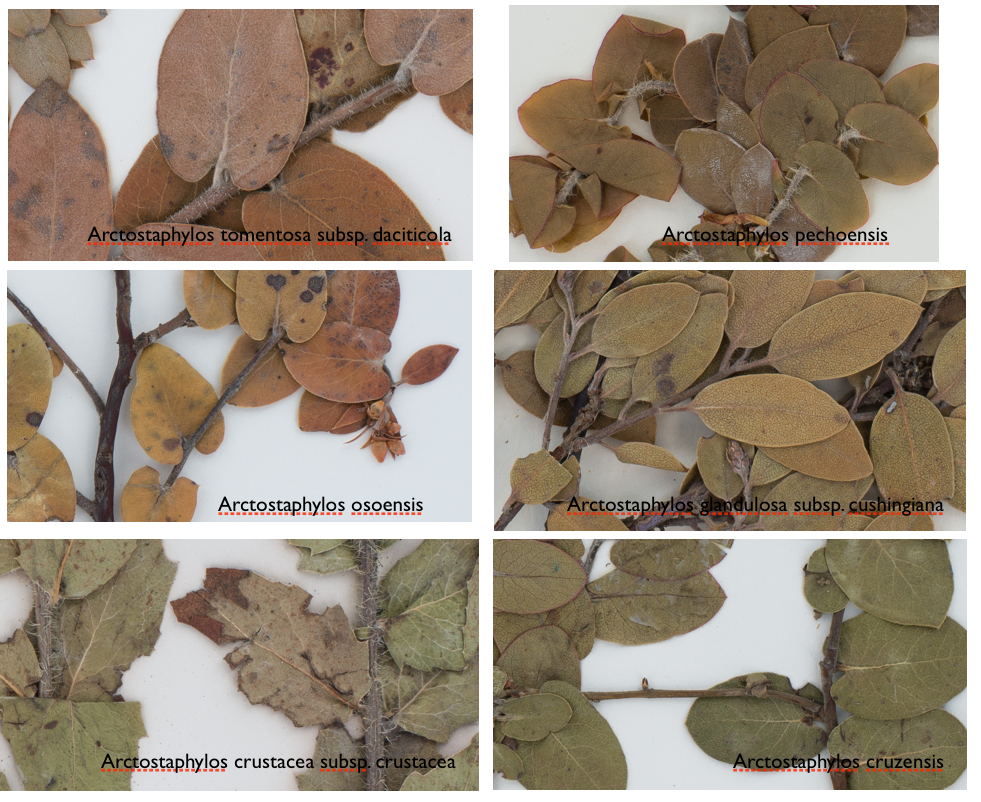
How many of you have photographed a manzanita in the field, or brought back a leaf, and then had trouble identifying it using a key? There are many manzanitas in the County, and a lot share common features. You ask yourself if what you have matches what is described in the key. One helpful tool is to use something like the CalFlora web site to see what other people thought as a match to the species name, but those photos may not flag key diagnostic features from the key. Don’t you wish you had a bunch of correctly identified specimens lying in front of you for comparison? Well… you can…. At the CCH2 web site you can enter and examine specimens from dozens of herbaria.
On the opening page, select ‘image search’ and then type in the latin binomial into the search page. You can also search by common name, family, or taxonomic group. Click Load Images to see thumbnails of all herbaria sheets matching your search criteria. Select a thumbnail, and another page will open with data on the sample. Open Large Image will open a high resolution picture of the specimen. Once loaded, your cursor will turn into the ‘+’ which allows extreme close up.
This is sufficiently detailed to enable you to see glands on stem hairs, and details of leaf surfaces, and you will have a lot of samples for most species. Those of you who attended the workshop before the last meeting were learning how to enter data from herbarium sheets, and this site is where a lot of the data will reside.
David Chipping
Introduce your friends and family members to native plants this holiday season with a gift from our chapter sales table at the December 5 meeting. When you buy items from the sales table at our meetings and events, you are supporting our chapter and getting a good deal because the chapter pays the sales tax. Plus you can walk out with your purchase in hand. We have a wide variety of books including field guides, how-to books, and books specific to San Luis Obispo County. Friends who do not know they are native plant enthusiasts yet may enjoy the gift of a well-made attractive t-shirt.
New this year, Marti Rutherford will be bringing seed packets that we will be selling for $1.00/packet (the seeds inside are
priceless). Native plant seeds are a great gift for kids and gardening fans that might enjoy growing plants themselves. Marti’s wildflower mix includes tidy tips (Layia platyglossa), clarkia (Clarkia unguiculata and purpurea), lupine (Lupinus succulentus), and California poppy (Eschscholzia californica).
We accept cash, checks, and credit cards. Dave Krause has been teaching me how to process credit card payments via PayPal on my iPad so I thank you in advance for your patience as I learn.
Linda Poppenheimer
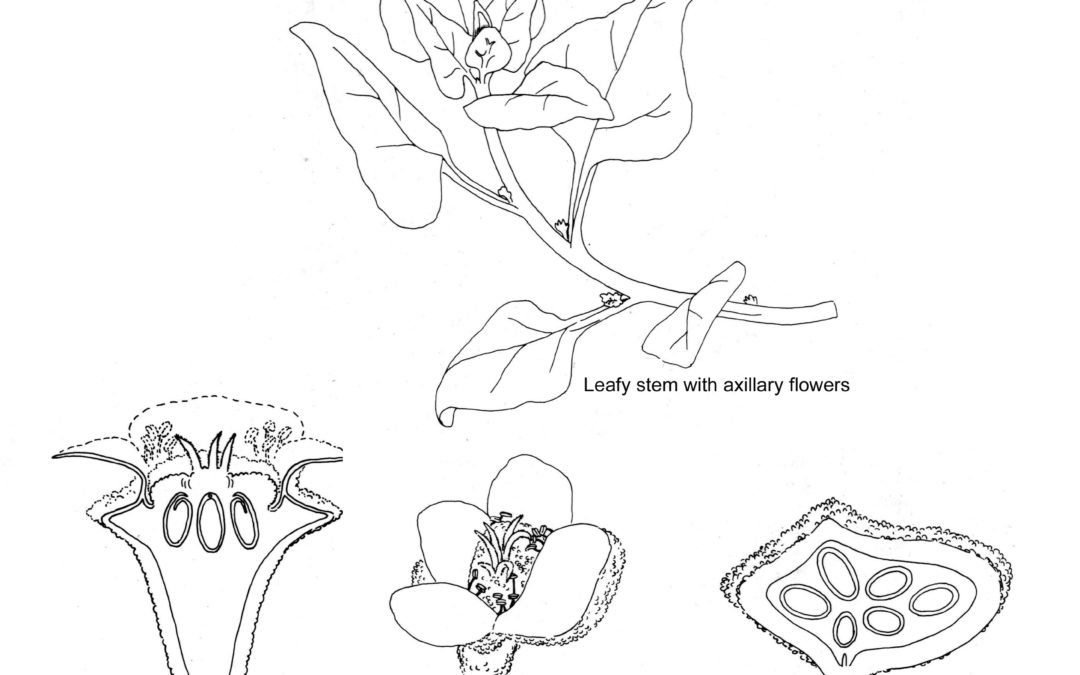
Bonnie’s drawing for this issue of OBISPOENSIS has never been used in any local newsletter. Bonnie drew it for Dr. David Keil and my plant taxonomy text back in the early 1970’s. Why has it not been used? Well, first a look at Bonnie’s drawing will indicate that the species produces inconspicuous flowers. It lacks petals, and the flowers are semi-hidden in the axils of its somewhat succulent leaves, and the species is not native to California. Its common names include New Zealand, or dune, spinach, Tetragonia tetragonoides. For you old timers like me, back in the 1970’s its most common published scientific name was Tetragonia expansa.
New Zealand spinach is considered by many to be an invasive weed. I assume we must go along with that, but my experience with it around here is that it’s not particularly good at it. It prefers slightly salty (halophilic) soils. It also seems to require a bit of disturbance. So, look for it at the upper, less salty edge of salt marsh and/or on coastal benches, especially in disturbed sites where few other species can grow. A few individual plants have been found along the edge of Los Osos Creek, west of Bay View bridge. It is especially common along the trails south of Spooner’s Cove in Montaña de Oro State Park, where it became sufficiently dense to warrant a targeted removal project. It can also be encountered as a weed all along the coast.
New Zealand spinach belongs to a family of flowering plants, Aizoaceae, that is primarily native to the Southern Hemisphere. New Zealand spinach is, in fact native to Southern Africa but has spread to New Zealand and is apparently a serious weed throughout southern Australia. Obviously, it has also been introduced into North America and Eurasia. The genus, Tetragonia, has around a dozen species and its generic name is derived from the four (tetra-) wings that are produced on the green fruit. These wings dry up and essentially disappear in the mature fruit. The inconspicuous flower displays a pale yellow color, but the flowers have no petals, only sepals as it only produces a single whorl of perianth (collective term for sepals and petals). If a perianth has only one whorl, botanists tend to regard them as sepals. These sepals, as well as the stamens are attached to the top of the ovary which makes the ovary inferior. The more famous and probably even more weedy members of the Aizoaceae are the ice plants
(Carpobrotus and Mesembryanthemum).
Wherever New Zealand spinach is found growing, its leaves have been used as a green vegetable. One web source indicated that the Magellan expedition around the world was especially happy to find a patch of it. They would pick the leaves, boil them and then dry (preserve) them for eating. It was particularly good in preventing scurvy! However, note that they boiled the leaves before eating them. The leaves contain enough oxalate chemicals to cause oxalate poisoning. Oxalate chemicals are usually destroyed by boiling.
Dirk Walters
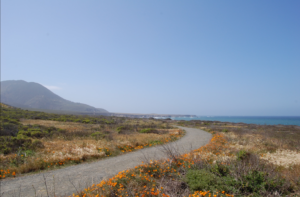
Bluff Trail, Montaña de Oro S.P., site of a New
Zealand spinach removal project to encourage the return of native plants. Photo by David Chipping
The impact on plant communities due to mandated vegetation clearance at the Wildland-Urban Interface appears to be extremely variable, even along individual sites such as the pine forest in Cambria. In some areas we have been told that all small trees and shrubs were removed, and in others they were selectively preserved. CNPS urges members to photograph treatment areas, so that we can better estimate the long term ecological effects.

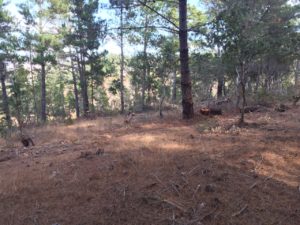
David Krause took these photos of untreated (left) and treated (right) areas in Cambria. Clearly the ‘fire ladder’ has been reduced, lessening the chance of crown fires, but wildlife habitat has been eliminated.
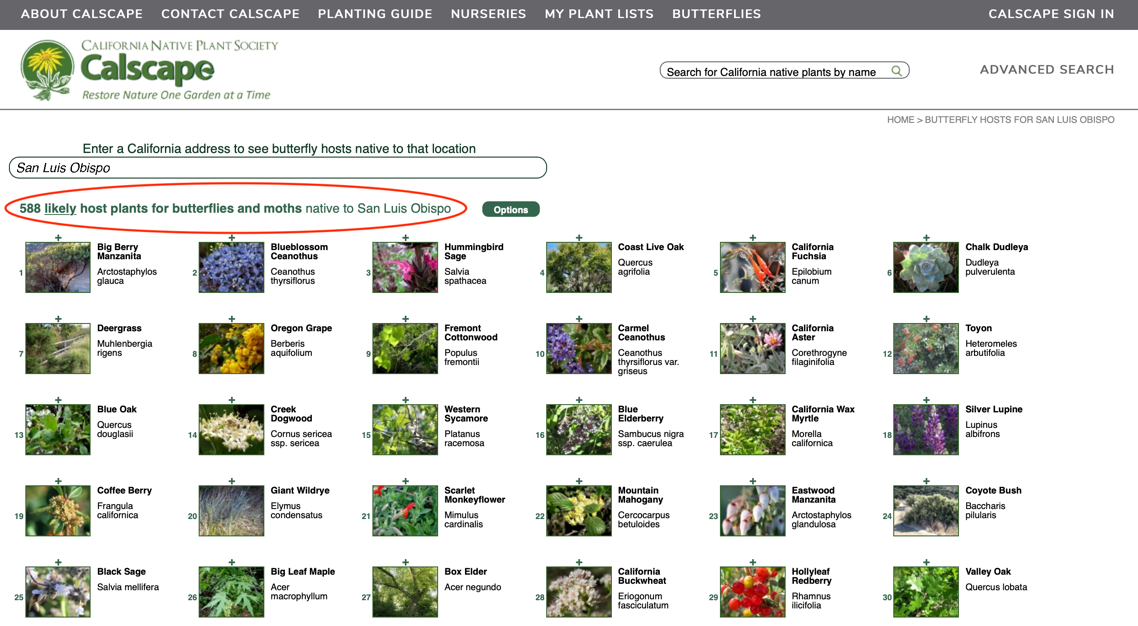
CNPS went live with past week with the new Calscape feature whereby users can search for host plants by butterfly species and location. This exciting addition to the Calscape website occurred during National Pollinator Week and is a tangible way ordinary folks can play a part in halting the dramatic insect decline.
Checkout the article on cnps.org >>
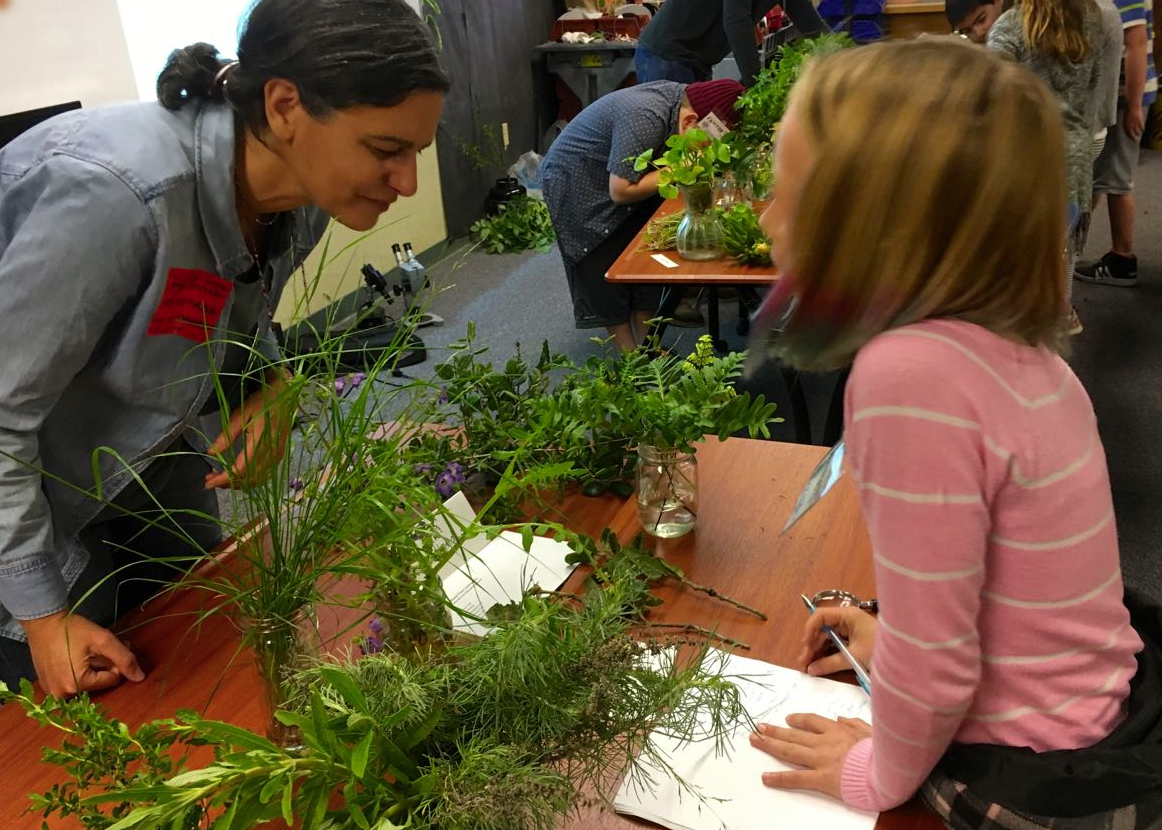
The stars finally aligned for us. On March 21, 2019, our chapter had the opportunity to work with Bev Gingg and Learning Among the Oaks, a program that has been working to introduce young children to the oak woodland community at the Santa Margarita Ranch, and, more recently, at the Pismo Preserve. The successful program, started in 2005, is now part of the Land Conservancy of San Luis Obispo and has grown so that it services Ocean View Elementary in Arroyo Grande in addition to Santa Margarita Elementary School, the original ‘home-base’ for the program. Children are recommended by their teachers to be part of the nine-week Oak Ambassador Training Program in which they learn how to serve as a docent and lead hikes in the oak woodland for younger students and their families. The Ambassadors receive comprehensive training about the oak ecosystem through classroom lectures and field visits, and spend time shadowing older Ambassadors as docents so they are prepared to do the same when they become fifth graders.
CNPS participated in one of the classroom trainings by preparing a botany lesson for a group of very motivated Ocean View Elementary fourth graders. We displayed numerous plant specimens representing plant communities of the Pismo Preserve, as well as plants that illustrated different seed dispersal methods and leaf arrangements. We knew that our efforts in preparing the lab were well-received when we heard the excited exclamations as the kids filed into the room. Our favorites: “It smells so good in here!” and “Botany is the best!” It was a whirlwind of an hour, packed with opportunities to learn about xylem tubes through the magic of celery and water cohesion by combining droplets together with a toothpick; discovering the parts of a flower through a keying exercise; smelling and questioning the pungent leaves of some of our common local plants; and, for a few lucky kids, getting ‘stamped’ with the lovely spore print of goldback fern on their clothes. We even had an excellent slideshow to pull it all together, created and presented by the engaging Lindsey Roddick.
Lindsey, Bill Waycott, and Susi Bernstein made up the CNPS team of “Plant Nerds” this time, but we welcome any of you reading this article to join us next spring. There are plans to expand the program to additional schools in the future, and CNPS has been asked to conduct botany lessons for these schools as well. Would you like to join us? There are bright children out there with receptive, spongy little brains. YOU could inspire and help mold them into future conservationists and CNPS members. -Susi
Here are a couple of projects CNPS is currently working on in Nipomo, CA. Last summer, we reported on work with a 5th Grade class at Dana Elementary School, who had helped plant a CA native garden on the north side of the Nipomo County Library. Now, six months later, that garden is flourishing and the librarian, Heidi LoCascio, has asked CNPS to organize a larger planting for the front of the Library. This new garden will be planted by the parents and children who use the library and live in the local community, at the end of April 2019.
The other project involves the current 5th Grade class at Dana Elementary, which is creating a California native and vegetable garden at their school. Two weeks ago, those kids sowed flats of wild flowers seeds (arroyo lupine, tidy tips, and CA poppies), along with lettuce seeds. By the end of April, the students will have prepared the garden soil, and by mid-May their native plant and veggie seedlings will be large enough to transplant into the garden, it is hoped that by the end of the school year during the second week of June, the kids will have flowers and veggies to take home and enjoy.
-Bill
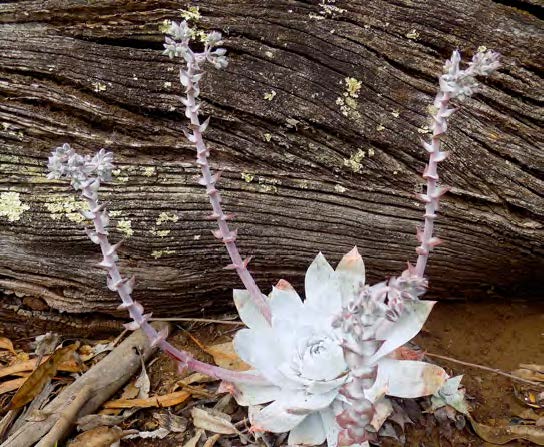
Last spring, the story of a Dudleya smuggler in Mendocino County hit the news when an observant person noticed something odd while waiting in line at the local post office. (Here’s a link to one of the news outlets covering that story.)
Now we have our own case of Dudleya smugglers caught stealing the native succulents from the cliffs in Big Sur. Read about that story here.
In both these instances, a concerned observer noticed odd behavior and acted on it. Customs was called to check the shipments from the Post Office, and the woman observing the poachers in Big Sur took photos of the smugglers and their license plate. If you see something, say something.
John Chesnut has created a beautiful article on propagating Dudleya – you can read it here. And if you are out and about and see someone stuffing plants in to a bag or prying Dudleya’s off a cliff, contact local law enforcement or CDFW. Our local office doesn’t have a phone number, but you can send an email to AskMarine@wildlife.ca.gov.
| Office | Address | Phone | Fax |
|---|---|---|---|
| Belmont Field Office and Laboratory | 350 Harbor Blvd., Belmont, CA 94002 | No general line | No general fax |
| Eureka Office and Laboratory | 619 2nd St., Eureka, CA 95501 | (707) 445-6493 | (707) 445-6664 |
| Fort Bragg Field Office and Laboratory | 32330 N. Harbor Dr., Fort Bragg, CA 95437 | (707) 964-9078 | (707) 964-0642 |
| Los Alamitos Field Office and Laboratory | 4665 Lampson Ave., Suite C, Los Alamitos, CA 90720 | (562) 342-7100 | (562) 596-0342 |
| Monterey Field Office and Laboratory | 20 Lower Ragsdale Dr., Suite 100, Monterey, CA 93940 | (831) 649-2870 | (831) 649-2894 |
| Sacramento Field Office | 1812 Ninth St., Sacramento, CA 95814 | No general line | (916) 445-6458 |
| San Diego Field Office and Laboratory | 3883 Ruffin Rd., San Diego, CA 92123 | (858) 467-4201 | No general fax |
| San Luis Obispo Field Office and Laboratory | 3196 South Higuera St., Suite A, San Luis Obispo, CA 93401 | No general line | (805) 542-4609 |
| Santa Barbara Field Office and Laboratory | 1933 Cliff Dr., Suite 9, Santa Barbara, CA 93109 | (805) 568-1231 | (805) 568-1235 |
| Santa Rosa Field Office | 5355 Skylane Blvd., Suite B, Santa Rosa, CA 95403 | (707) 576-2882 | (707) 576-7132 |
As we have just experienced an intense and prolonged drought, a team of scientists has just published in Nature Climate Change Letters an analysis of impacts in the Carrizo Plain. They quantified the responses of 423 species of plants, arthropods, birds, reptiles and mammals to California’s drought of 2012–2015—the driest period in the past 1,200 years for this global biodiversity hotspot.
The article by Prugh and others was published in Nature Climate Change Letters “Ecological winners and losers of extreme drought in California” August 20th, 2018 The report states that plants were most responsive to one-year water deficits, whereas vertebrates responded to longer-term deficits, and extended drought had the greatest impact on carnivorous animals. Perhaps surprisingly, locally rare species were more likely to increase in numbers and abundant species were more likely to decline in response to drought, and this effect was remarkably consistent across taxa and drought durations.
Of the mammals, California ground squirrel, San Joaquin kit fox and Giant kangaroo rat fared badly, while Southern grasshopper mouse and Short-nosed kangaroo rat were successful. For birds, barn owls and western meadowlarks declined, while killdeer and roadrunner populations remained stable. The rare Blunt-nosed leopard lizard suffered, but the coast horned lizard and side-blotched lizard were little affected. Spiders and scorpions declined, but certain beetles did well.
As was obvious to most people, nearly all plants were impacted, but certain hardy species such as Calandrinia were successful in the absence of competition. The study concludes that while extreme droughts can produce substantial short-term declines in the abundance and diversity of species, these disturbances may play a vital role in the long-term maintenance of biodiversity by inducing periodic die-offs of dominant species and subsequent opportunities for rare, yet fast-growing, species.
This study is especially useful as climate change projections indicate that extreme, extended droughts will become more common, as well as the maximum summer temperature, and the duration, intensity and timing of the rainy season.
As far as SLO Chapter is concerned, I am hoping we can work with Cal Poly, BLM, and the Friends of the Carrizo Plain to institute a long term monitoring program in which we can collect photographic and quantitative data on the conditions at different parts of the greater Carrizo Plain. There are already ongoing experiments in which exclosures are used to exclude
larger animals and, in an inner fence, rodents from the grasslands, but I don’t know of any broad vegetation assessments apart from the CNPS-generated vegetation map which was a snapshot of conditions, and is governed by the dominant plants rather that the complete population.
I would propose that this spring, we get together a group to select a series of areas that will be linked to GPS coordinates, and that the sites would be revisited and photographed (and possibly inventoried) a couple of times per year, and over many years. I am intending to meet with faculty at Cal Poly to see if they would see a way to direct a series of student projects in a similar effort.
-David Chipping
Marlin Harms will give a presentation in the Mind Walk series (Central Coast Parks Association) at the Inn at Morro Bay on Feb. 4. His program will feature his photography as well as aspects of biology and ecology of the organisms that live there.
Meetings start at 10:15, but may be standing room only by starting time as there is limited seating.
Free to members of CCSPA. $3 non-members. Details here.